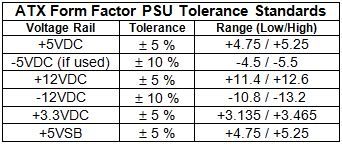
I can feel the power supply's heat over the casing
#1

 Posted 29 April 2011 - 09:28 AM
Posted 29 April 2011 - 09:28 AM

#2

 Posted 29 April 2011 - 09:39 AM
Posted 29 April 2011 - 09:39 AM

Unplug from the wall, open the side panel, and inspect for dust buildup and ensure cables are routed to minimize restricting front to back air flow.
What other case fans are there?
What are your temps?
#3

 Posted 29 April 2011 - 12:45 PM
Posted 29 April 2011 - 12:45 PM

here's the spec:
Amd Athlon 64 X2 4800+
Msi K9N NEOF v3
4GB DDR2 800 (2x2GB) (installed yesterday)
500Gb SATA HDD
320 IDE HDD
Sapphire Radeon HD 5750 1GB DDR5 (installed yesterday)
Hec Raptor 500 watts
I'll post my SS on my next reply,tnx!
#4

 Posted 29 April 2011 - 12:55 PM
Posted 29 April 2011 - 12:55 PM

#5

 Posted 04 May 2011 - 04:57 AM
Posted 04 May 2011 - 04:57 AM


hope this helps and we also encountered an error that states "VPU Recover has reset your graphics accelerator as it was no longer responding to graphics driver commands"
tnx in advance!
Edited by chickmazta, 04 May 2011 - 05:00 AM.
#6

 Posted 04 May 2011 - 06:42 AM
Posted 04 May 2011 - 06:42 AM

To properly and conclusively test a power supply unit (PSU), it must be tested under various realistic "loads" then analyzed for excessive ripple and other anomalies. This is done by a qualified technician using an oscilloscope or power analyzer - sophisticated (and expensive) electronic test equipment requiring special training to operate, and a basic knowledge of electronics theory to understand the results. Therefore, conclusively testing a power supply is done in properly equipped electronic repair facilities.
Fortunately, there are other options that are almost as good. I keep a FrozenCPU Ultimate PSU Tester in my tool bag when I am "in the field" and don't have a good spare power supply to swap in. While not a certain test, they are better than nothing. The advantage of this model is that it has an LCD readout of the voltage. With an actual voltage readout, you have a better chance of detecting a "failing" PSU, or one barely within specified ATX Form Factor Standard tolerances. Lesser models use LEDs to indicate the voltage is just within some "range". These are less informative, considerably cheaper, but still useful for detecting PSUs that have already "failed". Newegg has several testers to choose from. All these testers contain a "dummy load" to fool the PSU into thinking it is connected to a motherboard, and therefore allows the PSU to power on, if able, without being attached to a motherboard - great for testing fans, but again, it is not a true load or suitable for conclusive testing.
Note the required voltage tolerance ranges:

NOTE: Disregard the -5VDC reading. It is no longer used.
Swapping in a known good supply is a tried and true method of troubleshooting used for years, even by pros. If you have access to a suitably sized, spare power supply, carefully remove the suspect supply and replace it with the known good one, and see if the problem goes away.
I do not recommend using a multimeter to test power supplies. To do it properly, that is, under a realistic load, the voltages on all the pins must be measured while the PSU is attached to the motherboard and the computer powered on. This requires poking (with some considerable force) two hard and sharp, highly conductive meter probes into the main power connector, deep in the heart of the computer. One tiny slip can destroy the motherboard, and everything plugged into it. It is not worth the risk considering most multimeters, like plug-in testers, do not measure, or reveal any unwanted and potentially disruptive AC components to the DC voltages.
Note the ATX Form Factor standard does not "require" specific color coding for power supply connector wiring. It has recommendations but manufacturers often do not follow them. Sadly, many testing guides or tutorials will refer to wire color only and that can lead to improper testing.
The voltages can be checked in the BIOS Setup Menus of most motherboards but they do not reveal ripple or other anomalies either. And of course, booting into the BIOS Setup Menu requires a working PSU.
As always, before working in the interior of the computer case, take necessary ESD precautions to ensure static buildup in your body does not discharge through and destroy any sensitive devices. Unplug from the wall and touch bare metal of the case before reaching in. And remember, anything that plugs into the wall can kill. Do not open the power supply's case unless you are a qualified electronics technician. There are NO user-serviceable parts inside a power supply. If you do not have a tester or a suitable spare to swap in, take the PSU to a qualified technician for testing.
Oh, and note I was enlisted. So it's "Digerati, Sir" and not "Sir Digerati"!
#7

 Posted 05 May 2011 - 10:22 PM
Posted 05 May 2011 - 10:22 PM

HEC is the only brand I've been using since 2007. I've purchased it over 50+ times for my friends and family members, I didn't have any problems with it. but I've heard some negative feedbacks about it though. Here are some brands that I know, but haven't tried yet. Its available here in our country.
FSP, ACBel, Thermaltake, Coolermaster, Huntkey, Gigabyte, Antec etc... And how many watts do you suggest? Thank you very much for replying to me.
Edited by chickmazta, 05 May 2011 - 10:23 PM.
#8

 Posted 06 May 2011 - 06:37 AM
Posted 06 May 2011 - 06:37 AM

Use the eXtreme PSU Calculator Lite to determine the minimum and recommended power supply unit (PSU) requirements. Plan ahead and plug in all the hardware you think you might have in 2 or 3 years (extra drives, bigger or 2nd video card, more RAM, etc.). Be sure to read and heed the notes at the bottom of the calculator page. I recommend setting Capacitor Aging to 30% (see my note below), and if you participate in distributive computing projects (e.g. BOINC or Folding@Home) or extreme 3D animated gaming, I recommend setting both TDP and system load to 100%. These steps ensure the supply has adequate head room for stress free (and perhaps quieter) operation, as well as future hardware demands. Research your video card and pay particular attention to the power supply requirements for your card listed on your video card maker's website. If not listed, check a comparable card (same graphics engine and RAM) from a different maker. The key specifications, in order of importance are:
- Current (amperage or amps) on the +12V rail,
- Efficiency,
- Total wattage.
Most PSUs have an efficiency rating of around 70%. This means for every 100 watts of power a PSU draws from the wall, only 70 watts is delivered to the motherboard, with the rest wasted in the form of heat. The best supplies are 85 to 90% efficient, and as expected, cost more. I strongly recommend you pick a quality supply with an efficiency rating equal to or greater than 80%. Look for 80 PLUS and EnergyStar Compliant labels. 80 PLUS PSUs are required to have fairly linear efficiencies. This is important to ensure the PSU is running at or near peak efficiency regardless the load or power demands. Non-linear PSUs typically are most efficient when the load is in a narrow range between 70 and 90% of the PSU’s capacity and the efficiency may drop dramatically above and below those amounts.
Too big of a PSU hurts nothing but your budget. Your computer will draw from the PSU only what it needs, not what the PSU is capable of delivering. If a computer needs 300 watts it will draw 300 watts regardless if the PSU is a 400W, 650W, or 1000W PSU. In turn, the PSU, regardless its size will draw from the wall only what it needs to support the computer. In this example, it will draw 300 watts, plus another 45 – 90 watts, depending on the PSU’s inefficiency.
As noted, the eXtreme Calculator determines minimum and recommended requirements. If the calculator (with the changes I suggested) recommends a 400 watt minimum, a quality 400W supply will serve you just fine. However, a quality 550W – 600W supply will have, among other things, larger heat sinks to dissipate potentially more heat. It might have a larger fan too. The 400W supply will run most of the time closer to capacity, while the larger supply will be loafing along, rarely breaking a sweat. To help the smaller heat sinks get rid of the wasted 80 watts (20% of 400) of heat, the fan in the 400W supply may need to run full speed, while the fan in the larger supply, with bigger sinks just loafs along too – but in near silence. Also, it is typical for manufacturers to use higher quality parts, design, and manufacturing techniques in their higher power supplies.
Note: Capacitor Aging. All electronics “age” over time. Electrons flowing through components bang around and create friction and heat causing wear and tear, altering the electrical characteristics of the device. Over time, this weakens the device resulting in eventual failure. Power supplies have always suffered profoundly from aging effects resulting in a loss of capacity. In recent years, capacitor technologies have improved. The best PSUs use the best (and most expensive) capacitors which suffer less from aging effects than older capacitor types. If planning on buying a new, high-end PSU, setting capacitor aging to 10% may result in a more realistic recommendation. However, headroom “buffer” will be significantly reduced. You can expect your PSU to last 5 years or longer. Since it is better to buy too big rather than too small, and since it is hard to predict what your power requirements will be in 3 years, using 30% for Capacitor Aging ensures you have enough headroom for virtually any upgrade.
Don't forget to budget for a good UPS with AVR (automatic voltage regulation). Surge and spike protectors are inadequate and little more than fancy, expensive extension cords.
#9

 Posted 16 May 2011 - 04:03 AM
Posted 16 May 2011 - 04:03 AM

Edited by chickmazta, 16 May 2011 - 04:03 AM.
#10

 Posted 16 May 2011 - 07:11 AM
Posted 16 May 2011 - 07:11 AM

Similar Topics
0 user(s) are reading this topic
0 members, 0 guests, 0 anonymous users
As Featured On:














 Sign In
Sign In Create Account
Create Account

